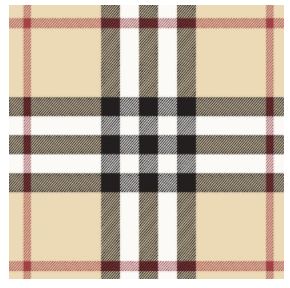The overlap between trade mark law and product design is illustrated nicely by two recent decisions.
Burberry, Italy
This hardly needs saying, but we often make purchases with reference to trade marks. You might go out shopping with your friend and say, "I'm looking for a Burberry coat". If you're a bit odd, you might say to your friend "I'm looking for one of those coats with a repeating plaid pattern consisting a tan background, light tan vertical and horizontal lines, black vertical and horizontal lines, with squares, and red vertical and horizontal lines." In fact, you are probably only like to do this if you are a patent attorney.
The repeating plain pattern description is in fact a registered trade mark and it belongs to the same company that owns the word mark Burberry. This pattern trade mark came up in litigation in Italy recently, when Burberry took action against a Chinese company that was selling lookalikes.

The litigation was long and tortuous. Burberry lost in the first court, with the court taking the view that, as the Chinese company had simply copied the pattern but not used the name Burberry, no-one would assume that their goods were associated with Burberry, which meant that there was no infringement. The next court, however, did accept that the pattern was an indicator of source. The matter then went up to the Supreme Court.
The Supreme Court accepted that the pattern has a reputation and does act as a source indicator, so it is a trade mark. It held that the mere reproduction of the pattern - even without any reproduction of the name Burberry - constituted trade mark infringement. This matter was seemingly decided under criminal provisions relating to trade mark infringement. Italian lawyers regard this as a favourable and important finding.
Fin-shaped jewellery, Israel
There's been a recent case in Israel where a company applied to register the shape of a fin as a three-dimensional trade mark in class 14 for jewellery and key holders.
The Trade Mark Office refused the application on the basis that the trade mark was not distinctive, but rather descriptive of jewellery in the shape of a shark fin. Citing case law, the office said that in order for a shape to be registrable, the following requirements apply:
- the shape must, in fact, function as a trade mark;
- the shape must not solely serve an aesthetic or functional purpose;
- as a result of use, the shape must have acquired a distinctive character that indicates the source of the goods.
The Trade Mark Office held that this was not the case here. The applicant had sold jewellery in the shape of a fin, but this did not mean that the fin shape was functioning as a trade mark or an indicator of source. In fact, the fin shape was there for aesthetic reasons, and the aesthetic character of the fin was so material that it prevented trade mark protection. A trade mark must be something other than the product itself. The office went on to suggest that the correct procedure would have been to file a registered design. Which brings us to:
Product design - trade marks or registered designs?
Product design including shape and pattern can be protected through trade mark law but it is often difficult. We've just seen this with the fin design jewellery in Israel, and we saw it recently in a UK case involving the shape of the Land Rover Defender. In that case, the judge was not persuaded that the shape of the Defender acts as a badge of origin, saying that the shape "may be unimportant, or may not even register, with average consumers." According to the judge, it is the brand names Land Rover and Defender that perform the trade mark function.
So, design law is sometimes the best way to go. In South Africa, it is possible to register both aesthetic designs and functional designs. With aesthetic designs, aspects of both shape and pattern qualify. Whereas distinctiveness is the big issue with trade marks, with registered designs it's all about novelty. So, if you think you have something that may qualify for protection as a registered design, contact me, but do so soon!
The content of this article is intended to provide a general guide to the subject matter. Specialist advice should be sought about your specific circumstances.

